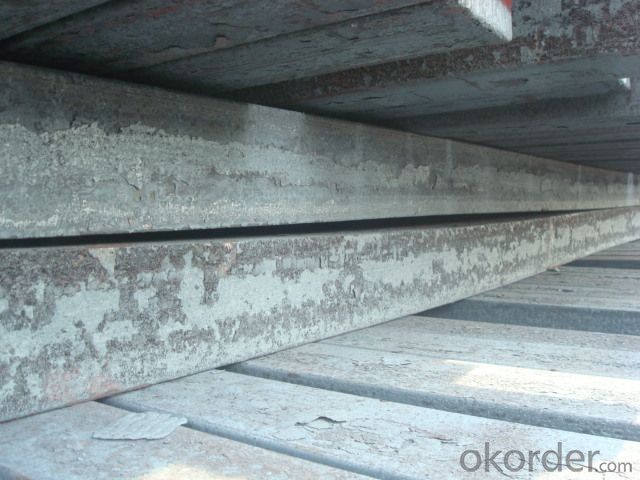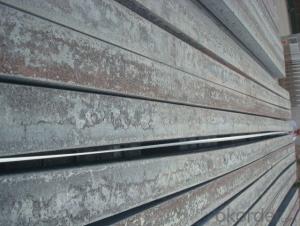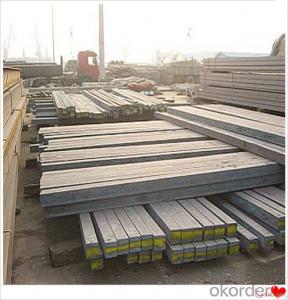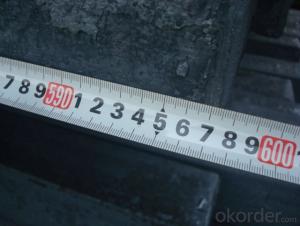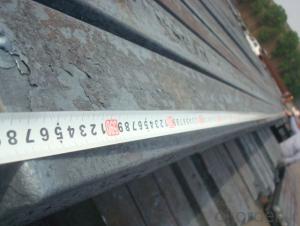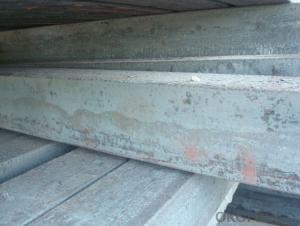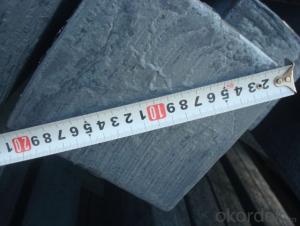Continue Casting Steel Bloom Made by Blasting Furnace
- Loading Port:
- Tianjin
- Payment Terms:
- TT OR LC
- Min Order Qty:
- 1000 m.t.
- Supply Capability:
- 100000 m.t./month
OKorder Service Pledge
OKorder Financial Service
You Might Also Like
Continue Casting Steel Bloom Made by Blasting Furnace
1.Structure of Continue Casting Steel Bloom Made by Blasting Furnace
Continue Casting Steel Bloom Made by Blasting Furnace
Steel ingot by cogging or breakdown of semi-finished products, is the raw material of all kinds of steel mill.Billet section of square, round, flat, rectangular and abnormity, etcSeveral, mainly related to shape of rolled products.Simple rolled section steel, choose close to finished product cross section of square billet or rectangular billet.rollingThe sector products such as flat steel, Angle steel, select the rectangular billet or slab.Had better profiled billet when production beams, channels, and in rolling processLines and improve the yield.The raw material of round billet is the production of seamless tube.See billet production billet production methods. Billet section size should meet the requirements of rolling deformation and finished product quality, but also roll strength and biting condition of restrictions.General steelBillet section heightH.And the roll diameterDThe ratio of the(namelyH/D)Should be less than or equal to zero0.5.Length of steel billet by finishing temperature,Rolling time and the length of the productOr times ruler.When heated too long accident prone to bump the furnace wall of steel, too short, furnace bottom utilization rate is not high, influence the heating furnace production.For the productionChoose a variety of steel and steel billet, should consider the affinities of billet, as far as possible in order to improve the productivity of the roughing mill, simplify the stock management of workshop.
2.Main Features of Continue Casting Steel Bloom Made by Blasting Furnace.
Continue Casting Steel Bloom Manufactured by Blasting Furnace section size should meet the requirements of rolling deformation and finished product quality, but also roll strength and biting condition of restrictions. General steel Billet section height H. And the roll diameter D The ratio of the ( namely H/D) Should be less than or equal to zero 0.5 . Length of steel billet by finishing temperature, Rolling time and the length of the product Or times ruler. When heated too long accident prone to bump the furnace wall of steel, too short, furnace bottom utilization rate is not high, influence the heating furnace production. For the production Choose a variety of steel and steel billet, should consider the affinities of billet, as far as possible in order to improve the productivity of the roughing mill, simplify the stock management of workshop.
3. Continue Casting Steel Bloom Made by Blasting FurnaceImages


4. Continue Casting Steel Bloom Made by Blasting Furnace Specification
1)SIZE
2)MATERIAL GRADE
3)CHEMICAL ELEMENTS COMPOSITONS
Material standard The editor Range of thickness: 150-240 - mm + / - 5 mm width range: 880-1530 - mm + / - 20 mm Length: 3700-10000 - mm + / - 500 - mm Cross-sectional size: 64 * 64; 82 * 82; 98 * 98; 124 * 124; 120 * 150; 152 * 164; 152 * 170 mm Length: 9000 mm Section of tolerance: billet: 1.0 + / - 2.0-1.0 + / - 1.0 mm slab: width: + / - 2.0 mm thickness: + / - 3.0 mm The length tolerance: + / - 200 mm Section diagonal tolerance: 3.5-8.0 MM Billet section size protrusions requirements: < 1242 mm, do not allow; > = 1242 mm, < = 2 mm 1242 mm, < = 3 mm Beheading (shear) extension deformation: < 1242 mm billet: no control; The slab: < = 15 mm Surface tilt: no more than billet section 0.1 Bending: every 1 m length is not more than 10 mm The distortion: length < = 5 m, < = 11. ; The length of the < = 7.5 M, < = 5. Material % 3 sp/PS chemical composition: C Mn Si S P
5.FAQ of Continue Casting Steel Bloom Made by Blasting Furnace
We have organized several common questions for our clients,may help you sincerely:
①How to regonized your products when the shipment arrive?
We will marked the painting in the end of the steel billet, and send you the MTC with the heart no. same as marked in the steel billets.
②How many days for the SGS inpecting the quantity and weight?
It depens on the quantity usually it is about 4000tons one day..
③What kinds of the grade you can supply?
We can supply Q195, Q215,Q235 and other kinds of the grade as our customers need.
- Q: How are steel billets used in the manufacturing of structural steel?
- Steel billets are a crucial raw material in the manufacturing of structural steel. They are heated, shaped, and then cooled to form various steel products such as beams, columns, and plates. These billets serve as the starting point for the production process, where they are further processed and transformed into different shapes and sizes to meet the specific requirements of construction projects.
- Q: What are the different types of surface defect detection equipment for steel billets?
- Steel billets have a variety of surface defect detection equipment available. These equipment are specifically designed to identify and analyze defects on the surface of steel billets, ensuring that only top-notch products are used for different applications. Some of the diverse types of surface defect detection equipment for steel billets include: 1. Ultrasonic Testing (UT): UT equipment utilizes sound waves to detect surface defects in steel billets. It emits high-frequency sound waves that penetrate the material and bounce back when they come across any surface irregularities. This method aids in the identification of cracks, voids, and other defects on the surface. 2. Eddy Current Testing (ECT): ECT equipment uses electromagnetic induction to detect surface defects in steel billets. It operates by passing an alternating current through a coil, generating a magnetic field that interacts with the conductive material of the billet. Any surface defect or irregularity causes a change in the magnetic field, which can be measured and analyzed. 3. Magnetic Particle Inspection (MPI): MPI equipment utilizes magnetic fields and iron particles to detect surface defects in steel billets. The billet is magnetized, and iron particles are applied to its surface. These particles gather around any surface defect, creating visible indications that can be easily identified and evaluated. 4. Visual Inspection: Visual inspection equipment involves the use of cameras, lasers, and other optical devices to detect surface defects in steel billets. These devices capture images or videos of the billet's surface, enabling inspectors to visually identify any irregularities or defects. 5. Thermographic Testing: Thermographic equipment uses infrared cameras to detect surface defects in steel billets by measuring temperature variations. Any defect causes a difference in heat transfer, resulting in distinct thermal patterns that can be detected and analyzed. 6. X-ray Inspection: X-ray inspection equipment employs X-ray radiation to penetrate the steel billet and detect internal and surface defects. It provides detailed images that allow inspectors to identify cracks, voids, and other defects that are not visible to the naked eye. In summary, these various types of surface defect detection equipment for steel billets offer a range of methods to ensure the quality and integrity of the billets, enabling manufacturers to deliver high-quality steel products to different industries.
- Q: How do steel billets contribute to the manufacturing of kitchen appliances?
- Steel billets are used as raw materials in the manufacturing of kitchen appliances because of their excellent strength, durability, and heat resistance properties. These billets are melted and formed into various shapes, such as sheets or rods, which are then used to create the structures and components of kitchen appliances. Steel billets ensure that kitchen appliances can withstand heavy use, high temperatures, and retain their structural integrity, making them an essential component in the manufacturing process.
- Q: How are steel billets used in the production of marine parts?
- Steel billets serve as a vital element in the manufacturing process of marine parts. These semi-finished steel products act as the raw material for shaping and forming a variety of marine components. To commence, steel billets undergo a procedure known as hot rolling. This involves subjecting them to high temperatures and passing them through rolling mills to attain different shapes and sizes. By undergoing hot rolling, the steel's grain structure is refined, thereby enhancing its mechanical properties and rendering it suitable for marine applications. Once the desired shape and size are achieved, these billets are further processed using various techniques such as forging, machining, and welding to create specific marine parts. Propeller shafts, rudder stocks, hull frames, and bulkheads are examples of marine components produced using steel billets. The exceptional strength and durability of steel make it an excellent choice for manufacturing marine parts, as it can withstand the harsh conditions of saltwater, extreme temperatures, and heavy loads. Moreover, steel billets can be easily customized to meet specific design requirements, ensuring the production of precise and dependable marine parts. Additionally, steel billets play a crucial role in the repair and maintenance of marine vessels. When existing components need replacement, steel billets can be shaped and machined to match the exact specifications of the original parts. This guarantees compatibility and seamless integration, facilitating efficient repairs and ensuring the uninterrupted operation of marine vessels. In conclusion, steel billets are indispensable in the production of marine parts as they provide the necessary raw material for shaping and forming various components. The combination of high strength, durability, and customization capabilities makes steel billets an ideal choice for marine applications, ensuring the reliability and performance of marine vessels.
- Q: What is the typical composition of steel billets?
- The typical composition of steel billets consists of primarily iron and carbon, with small amounts of other elements such as manganese, silicon, and sulfur.
- Q: What are the common sizes of steel billets?
- The sizes of steel billets can differ depending on the specific industry and application. However, there are various standard sizes that are frequently utilized. In the construction sector, steel billets commonly measure between 100mm x 100mm and 200mm x 200mm. These sizes are often employed in the fabrication of structural steel, such as beams, columns, and other load-bearing elements. For the production of automotive parts, the usual sizes of steel billets typically range from 150mm x 150mm to 250mm x 250mm. These sizes are commonly employed in forging and machining processes to manufacture components like crankshafts, connecting rods, and gears. In the oil and gas industry, larger steel billets are often necessary for manufacturing pipes and tubes. The typical sizes for this purpose range from 350mm x 350mm to 500mm x 500mm. These larger billets enable the production of seamless pipes capable of withstanding high-pressure environments. It should be noted that these are only general sizes and can vary depending on specific project requirements and regional standards. Additionally, customized sizes can also be produced based on the customer's requirements.
- Q: What are the common uses of steel billets?
- Steel billets, serving as a precursor to different steel products, are semi-finished metal goods. They typically take on a solid, rectangular shape through continuous casting or hot rolling. Steel billets find wide application in various industries due to their strength and versatility. One of the primary uses of steel billets is in the production of long steel products like bars, rods, and wires. These billets act as the initial material for further processing, where they are reheated and shaped into the desired form. Long steel products are extensively employed in construction, infrastructure development, manufacturing, and transportation industries. Steel billets are also utilized in the manufacturing of seamless pipes and tubes. Through the process of piercing and elongation, the billets can be converted into seamless tubes, which are widely employed in oil and gas exploration, automotive manufacturing, and structural engineering. Moreover, steel billets play a vital role in producing forged steel components. Forging involves shaping the heated billet under pressure, resulting in durable and high-strength products. These forged components find wide application in industries such as aerospace, automotive, and power generation. Additionally, steel billets are used in the production of various other steel products, including beams, channels, and profiles for construction purposes, as well as machine parts and tools. In conclusion, steel billets serve as the starting material for the production of long steel products, seamless pipes, forged components, and other steel goods. Their malleability, strength, and versatility make steel billets an indispensable raw material in numerous industries.
- Q: What is the shelf life of a steel billet?
- The shelf life of a steel billet is indefinite as long as it is stored in a dry and controlled environment to prevent corrosion.
- Q: How are steel billets tested for strength and durability?
- Steel billets are tested for strength and durability through various methods such as tensile testing, hardness testing, impact testing, and microstructure examination. These tests help determine the strength, ductility, and resistance to deformation and fracture of the steel billets, ensuring their suitability for various applications.
- Q: What are the different types of steel billet rolling mills?
- The steel industry utilizes various types of steel billet rolling mills to shape and size heated steel bars known as billets. Some commonly used mills include: 1. Two-high rolling mills: These mills feature two rolls positioned vertically. Pressure is applied to the billet as it passes between the rolls, shaping the steel to the desired form. 2. Three-high rolling mills: These mills have three rolls, with the middle roll being larger in diameter than the top and bottom rolls. The billet is passed through these rolls, with the middle roll applying the majority of the shaping pressure. 3. Four-high rolling mills: These mills consist of two smaller rolls positioned above two larger rolls. The billet is first passed through the smaller rolls, shaping the steel, before being further refined by passing through the larger rolls. 4. Cluster rolling mills: In this type of mill, multiple rolls are arranged in a cluster. The billet is passed through these rolls, which apply pressure from various angles and directions, shaping the steel. 5. Tandem rolling mills: These mills are composed of multiple stands of rolling mills arranged in a tandem configuration. Each stand performs a specific shaping operation on the billet, and the billet is sequentially passed through each stand until the desired shape is achieved. 6. Continuous rolling mills: Designed for high-volume production, these mills operate continuously. The billet is fed into the mill without interruption, and the rolls continuously apply pressure to shape the steel as it passes through. Each type of steel billet rolling mill offers its own advantages and is suited for specific applications within the steel industry. The choice of mill depends on factors such as the desired final product shape and size, production volume, and the specific requirements of the steel being processed.
Send your message to us
Continue Casting Steel Bloom Made by Blasting Furnace
- Loading Port:
- Tianjin
- Payment Terms:
- TT OR LC
- Min Order Qty:
- 1000 m.t.
- Supply Capability:
- 100000 m.t./month
OKorder Service Pledge
OKorder Financial Service
Similar products
Hot products
Hot Searches
Related keywords


